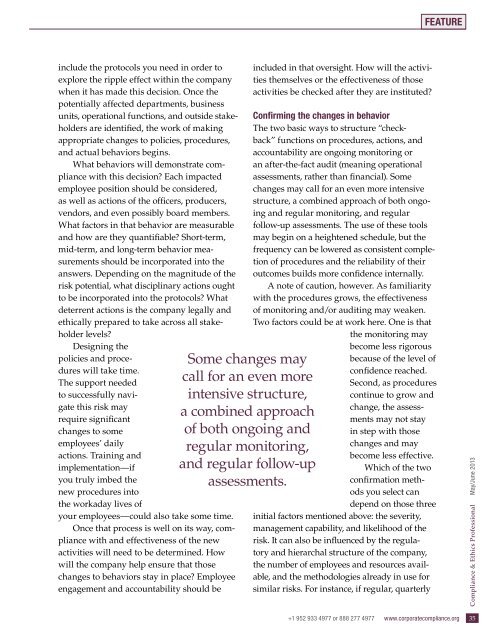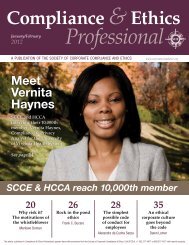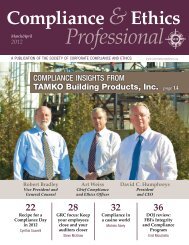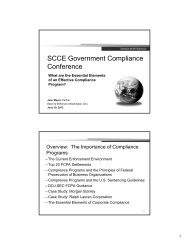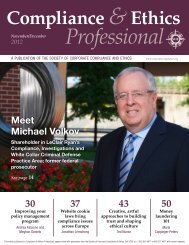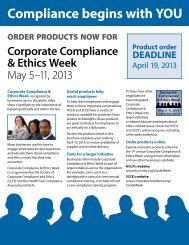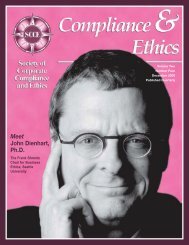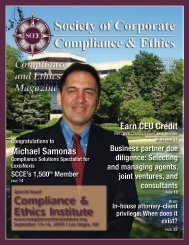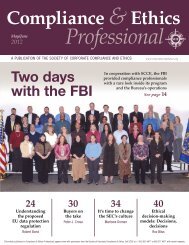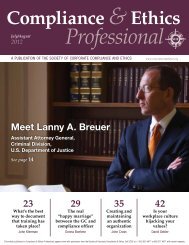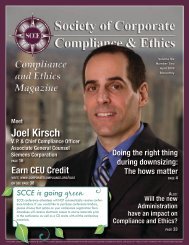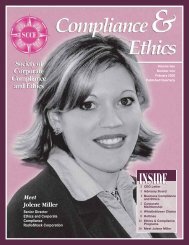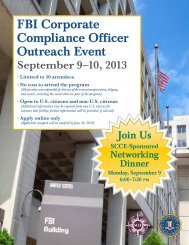Compliance &Ethics - Society of Corporate Compliance and Ethics
Compliance &Ethics - Society of Corporate Compliance and Ethics
Compliance &Ethics - Society of Corporate Compliance and Ethics
- No tags were found...
You also want an ePaper? Increase the reach of your titles
YUMPU automatically turns print PDFs into web optimized ePapers that Google loves.
Featureinclude the protocols you need in order toexplore the ripple effect within the companywhen it has made this decision. Once thepotentially affected departments, businessunits, operational functions, <strong>and</strong> outside stakeholdersare identified, the work <strong>of</strong> makingappropriate changes to policies, procedures,<strong>and</strong> actual behaviors begins.What behaviors will demonstrate compliancewith this decision? Each impactedemployee position should be considered,as well as actions <strong>of</strong> the <strong>of</strong>ficers, producers,vendors, <strong>and</strong> even possibly board members.What factors in that behavior are measurable<strong>and</strong> how are they quantifiable? Short-term,mid-term, <strong>and</strong> long-term behavior measurementsshould be incorporated into theanswers. Depending on the magnitude <strong>of</strong> therisk potential, what disciplinary actions oughtto be incorporated into the protocols? Whatdeterrent actions is the company legally <strong>and</strong>ethically prepared to take across all stakeholderlevels?Designing thepolicies <strong>and</strong> procedureswill take time.The support neededto successfully navigatethis risk mayrequire significantchanges to someemployees’ dailyactions. Training <strong>and</strong>implementation—ifyou truly imbed thenew procedures intothe workaday lives <strong>of</strong>your employees—could also take some time.Once that process is well on its way, compliancewith <strong>and</strong> effectiveness <strong>of</strong> the newactivities will need to be determined. Howwill the company help ensure that thosechanges to behaviors stay in place? Employeeengagement <strong>and</strong> accountability should beSome changes maycall for an even moreintensive structure,a combined approach<strong>of</strong> both ongoing <strong>and</strong>regular monitoring,<strong>and</strong> regular follow-upassessments.included in that oversight. How will the activitiesthemselves or the effectiveness <strong>of</strong> thoseactivities be checked after they are instituted?Confirming the changes in behaviorThe two basic ways to structure “checkback”functions on procedures, actions, <strong>and</strong>accountability are ongoing monitoring oran after-the-fact audit (meaning operationalassessments, rather than financial). Somechanges may call for an even more intensivestructure, a combined approach <strong>of</strong> both ongoing<strong>and</strong> regular monitoring, <strong>and</strong> regularfollow-up assessments. The use <strong>of</strong> these toolsmay begin on a heightened schedule, but thefrequency can be lowered as consistent completion<strong>of</strong> procedures <strong>and</strong> the reliability <strong>of</strong> theiroutcomes builds more confidence internally.A note <strong>of</strong> caution, however. As familiaritywith the procedures grows, the effectiveness<strong>of</strong> monitoring <strong>and</strong>/or auditing may weaken.Two factors could be at work here. One is thatthe monitoring maybecome less rigorousbecause <strong>of</strong> the level <strong>of</strong>confidence reached.Second, as procedurescontinue to grow <strong>and</strong>change, the assessmentsmay not stayin step with thosechanges <strong>and</strong> maybecome less effective.Which <strong>of</strong> the twoconfirmation methodsyou select c<strong>and</strong>epend on those threeinitial factors mentioned above: the severity,management capability, <strong>and</strong> likelihood <strong>of</strong> therisk. It can also be influenced by the regulatory<strong>and</strong> hierarchal structure <strong>of</strong> the company,the number <strong>of</strong> employees <strong>and</strong> resources available,<strong>and</strong> the methodologies already in use forsimilar risks. For instance, if regular, quarterly<strong>Compliance</strong> & <strong>Ethics</strong> Pr<strong>of</strong>essional May/June 2013+1 952 933 4977 or 888 277 4977 www.corporatecompliance.org 35


